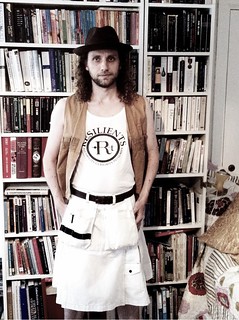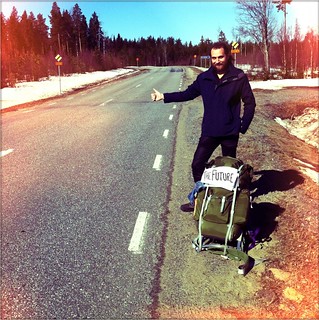Artists in Transience
by Dougald Hine
I am thinking about Walter Benjamin’s ‘The Storyteller’, the two archetypes he describes: the storyteller who travels and brings the stories from elsewhere, and the storyteller who stays put and holds the stories of a particular place. How do we learn to do both things – to move on, and to stay put – with greater awareness of their effect on ourselves and on others? – Dougald Hine
- Words Which Matter to People, Dougald's article reflecting on his search for the meaning of “resilience”
- Dougald Hine in conversation with Shelbatra Jashari towards the end of his journey, in Rab, Croatia
- The Dark Mountain Project blog: http://dark-mountain.net/blog/residing/
Journeyers and Guilds
In the guilds of the middle ages, a journeyman was someone who had completed his apprenticeship and was competent in his craft, but had not yet risen to the level of master. The word could be misleading – “journey” is actually “journée”, referring to the status of a day-labourer – yet there is a long tradition of the wandering journeyman, moving from place to place to learn more about how his craft is being practiced. In parts of Europe, this continues to the present day.
The Guild of Resilients is a new association whose members come from across Europe. Its aim is to cultivate the skills required to thrive in uncertain, turbulent times. I was asked by its founders (FoAM) to investigate what it might mean to be a “journeyer” in the practice of such skills.
This invitation led to more questions than answers: what do we mean when we use the word “resilience”? What aspects of our situation does it bring into view, and what aspects might it obscure? What skills might the members of such a guild have in common?
Culture and Resilience
Within the range of possibilities these questions offered, I chose to focus on what I have tended to call deep cultural resilience. As a starting point, I wrote, perhaps resilience is best understood as the capacity to endure.
I am particularly interested in the role that culture plays in this: culture in the narrow sense of the arts – because I suspect that those who have dedicated their lives to their creative work have useful lessons for how we make a good job of living through difficult times – but also culture in the broader anthropological sense, the ways of being and doing and seeing which give shape to life in a particular place and time.
The Journey
I set off from Stockholm on the evening of 8 July, 2012.
For the first two weeks, I travelled fast: visiting people and projects that had been on my mind, recording the traces of the journey and the chance encounters to which it led. After that, I slowed down, spending time with groups of friends and collaborators, first in Croatia and later in Denmark. All of these journeys were made by rail and by ferry. Over the later part of the summer, I began to write up some of the longer reflections from the journey, picking up further threads of conversation along the way.
More about this journey can be found on Dougald's Resilients Journey blog: http://rhapsodi.se/resilients/

